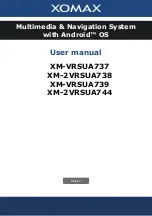
iPhone
“
Works with iPhone
”
means that an electronic
accessory has been designed to connect spe-
cifically to iPhone and has been certified by
the developer to meet Apple performance
standards.
Apple is not responsible for the operation of
this device or its compliance with safety and
regulatory standards.
iPhone is a trademark of Apple Inc.
iTunes
iTunes is a trademark of Apple Inc., registered
in the U.S. and other countries.
Using the LCD screen correctly
Handling the LCD screen
!
When the LCD screen is subjected to direct
sunlight for a long period of time, it will be-
come very hot, resulting in possible da-
mage to the LCD screen. When not using
this navigation system, avoid exposing it to
direct sunlight as much as possible.
!
The LCD screen should be used within the
temperature ranges shown in
“
Specifica-
tions
”
.
!
Do not use the LCD screen at temperatures
higher or lower than the operating tem-
perature range, because the LCD screen
may not operate normally and could be da-
maged.
!
The LCD screen is exposed in order to in-
crease its visibility within the vehicle.
Please do not press strongly on it as this
may damage it.
!
Do not push the LCD screen with excessive
force as this may scratch it.
!
Never touch the LCD screen with anything
besides your finger when operating the
Touch panel functions. The LCD screen can
scratch easily.
Liquid crystal display (LCD) screen
!
If the LCD screen is near the vent of an air
conditioner, make sure that air from the air
conditioner is not blowing on it. Heat from
the heater may break the LCD screen, and
cool air from the cooler may cause moist-
ure to form inside the navigation unit, re-
sulting in possible damage.
!
Small black dots or white dots (bright dots)
may appear on the LCD screen. These are
due to the characteristics of the LCD
screen and do not indicate a malfunction.
!
The LCD screen will be difficult to see if it is
exposed to direct sunlight.
!
When using a mobile phone, keep the an-
tenna of the mobile phone away from the
LCD screen to prevent disruption of the
video in the form of disturbances such as
spots or coloured stripes.
Maintaining the LCD screen
!
When removing dust from the LCD screen
or cleaning it, first turn the system power
off, then wipe with a soft dry cloth.
!
When wiping the LCD screen, take care not
to scratch the surface. Do not use harsh or
abrasive chemical cleaners.
LED (light-emitting diode)
backlight
A light emitting diode is used inside the dis-
play to illuminate the LCD screen.
!
At low temperatures, using the LED back-
light may increase image lag and degrade
the image quality because of the character-
istics of the LCD screen. Image quality will
improve with an increase in temperature.
Appendix
Engb
158
Appendix













































